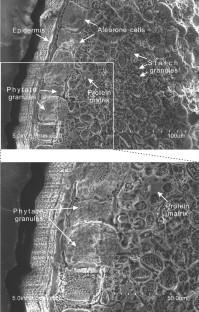Cereal Research Communications ( IF 1.6 ) Pub Date : 2022-04-26 , DOI: 10.1007/s42976-022-00269-y Cheng Wang , Yunlang Lu , Jianhua Wang , Cong Zhong

|
Trace elements play a crucial role in the growth and health of organisms. Imaging the distribution of trace elements in organisms at micron resolution scale can reveal the chemical form and transfer mechanism of trace elements in organisms and their influence on the growth of organisms. In the present study, we used a high-resolution secondary ion mass spectrometer (NanoSIMS) to image the trace elements zinc (Zn), iron (Fe), magnesium (Mg) and potassium (K) in the wheat grain and analyzed the chemical form of Zn. The NanoSIMS images indicate that the micro-distributions of Zn, Fe, Mg and K in the wheat grain are similar, especially for Zn and Fe, mostly in the phytate granules of the aleurone and closely associated with P and H–O. Besides being distributed in phytate granules, some or a small amount of Mg and K are also distributed in starch granules of the endosperm. The S and C–N distributions are very similar, mainly in the protein matrix of the endosperm and aleurone. P and H–O, rather than S and C–N, are the two dominant ligands to Zn, Fe, K and Mg in wheat grain. The dominant chemical form of Zn and Fe in the wheat grain is in the phytate, not the protein. The P is crucial to Zn, Fe, Mg and K accumulation in the wheat, and agricultural producers should pay special attention to adjust the application of P fertilizer to affect the concentrations of Zn in the crop. In situ imaging of NanoSIMS can elucidate the relations between trace elements in grain samples with clear visualization, and it also has great significance in chemical analysis, crop breeding and environmental monitoring.
Graphical abstract
中文翻译:

小麦籽粒中锌和微量元素的亚细胞分布:使用 NanoSIMS 进行原位成像
微量元素在生物体的生长和健康中起着至关重要的作用。以微米分辨率对生物体内微量元素的分布进行成像,可以揭示生物体内微量元素的化学形态和转移机制及其对生物体生长的影响。在本研究中,我们使用高分辨率二次离子质谱仪 (NanoSIMS) 对小麦籽粒中的微量元素锌 (Zn)、铁 (Fe)、镁 (Mg) 和钾 (K) 进行成像并分析化学成分。锌的形式。NanoSIMS 图像表明,小麦籽粒中 Zn、Fe、Mg 和 K 的微量分布相似,尤其是 Zn 和 Fe,主要在糊粉的植酸盐颗粒中,并与 P 和 H-O 密切相关。除了分布在植酸盐颗粒中,部分或少量的Mg和K也分布在胚乳的淀粉颗粒中。S 和 C-N 分布非常相似,主要在胚乳和糊粉的蛋白质基质中。P 和 H-O,而不是 S 和 C-N,是小麦籽粒中 Zn、Fe、K 和 Mg 的两个主要配体。小麦籽粒中锌和铁的主要化学形式是植酸盐,而不是蛋白质。磷对小麦中锌、铁、镁、钾的积累至关重要,农业生产者应特别注意调整磷肥的施用,以影响作物中锌的浓度。NanoSIMS的原位成像可以清晰地可视化阐明谷物样品中微量元素之间的关系,在化学分析、作物育种和环境监测方面也具有重要意义。S 和 C-N 分布非常相似,主要在胚乳和糊粉的蛋白质基质中。P 和 H-O,而不是 S 和 C-N,是小麦籽粒中 Zn、Fe、K 和 Mg 的两个主要配体。小麦籽粒中锌和铁的主要化学形式是植酸盐,而不是蛋白质。磷对小麦中锌、铁、镁、钾的积累至关重要,农业生产者应特别注意调整磷肥的施用,以影响作物中锌的浓度。NanoSIMS的原位成像可以清晰地可视化阐明谷物样品中微量元素之间的关系,在化学分析、作物育种和环境监测方面也具有重要意义。S 和 C-N 分布非常相似,主要在胚乳和糊粉的蛋白质基质中。P 和 H-O,而不是 S 和 C-N,是小麦籽粒中 Zn、Fe、K 和 Mg 的两个主要配体。小麦籽粒中锌和铁的主要化学形式是植酸盐,而不是蛋白质。磷对小麦中锌、铁、镁、钾的积累至关重要,农业生产者应特别注意调整磷肥的施用,以影响作物中锌的浓度。NanoSIMS的原位成像可以清晰地可视化阐明谷物样品中微量元素之间的关系,在化学分析、作物育种和环境监测方面也具有重要意义。是小麦籽粒中锌、铁、钾和镁的两个主要配体。小麦籽粒中锌和铁的主要化学形式是植酸盐,而不是蛋白质。磷对小麦中锌、铁、镁、钾的积累至关重要,农业生产者应特别注意调整磷肥的施用,以影响作物中锌的浓度。NanoSIMS的原位成像可以清晰地可视化阐明谷物样品中微量元素之间的关系,在化学分析、作物育种和环境监测方面也具有重要意义。是小麦籽粒中锌、铁、钾和镁的两个主要配体。小麦籽粒中锌和铁的主要化学形式是植酸盐,而不是蛋白质。磷对小麦中锌、铁、镁、钾的积累至关重要,农业生产者应特别注意调整磷肥的施用,以影响作物中锌的浓度。NanoSIMS的原位成像可以清晰地可视化阐明谷物样品中微量元素之间的关系,在化学分析、作物育种和环境监测方面也具有重要意义。农业生产者应特别注意调整磷肥的施用,以影响作物中锌的浓度。NanoSIMS的原位成像可以清晰地可视化阐明谷物样品中微量元素之间的关系,在化学分析、作物育种和环境监测方面也具有重要意义。农业生产者应特别注意调整磷肥的施用,以影响作物中锌的浓度。NanoSIMS的原位成像可以清晰地可视化阐明谷物样品中微量元素之间的关系,在化学分析、作物育种和环境监测方面也具有重要意义。


























 京公网安备 11010802027423号
京公网安备 11010802027423号